The
History of the Thanksgiving Holiday
by Rob Ramsdale 11/9/04
|
|
History
of the Thanksgiving Holiday
|
|
|
In 1621, the Plymouth colonists and
the native Wampanoag came together for a 3 day harvest
feast in what most consider to be the first Thanksgiving.
The Pilgrims' first Thanksgiving began at some unknown
date between September 21 and November 9, but most
likely in very early October.
Few people realize that the Pilgrims
did not celebrate Thanksgiving the next year, or
any year thereafter. Prior to the mid-1800s, Thanksgiving
had nothing to do with the 1621 harvest celebration,
Pilgrims or Native People. Thanksgiving started
as a traditional New England holiday that celebrated
family and community. This tradition began in England
and was brought by the Pilgrims to America. It descended
from Puritan days of fasting and festive rejoicing.
The governor of each colony or state declared a
day of thanksgiving each autumn, to give thanks
for general blessings. As New Englanders moved west
in the late 18th and early 19th centuries, they
took their holiday with them. After the harvest,
governors across the country proclaimed individual
Thanksgivings, and families traveled back to their
original homes for family reunions, church services
and large meals.
For over 200 years, many Americans
were celebrating some version of "Thanksgiving"
after the fall harvest but there was no set holiday
and it undoubtedly had a wide variety of meanings
depending on the heritage and upbringing of each
individual. The Pilgrims, Wampanoag and Thanksgiving
were first linked together in 1841, when historian
Alexander Young rediscovered Edward Winslow’s
account of the 1621 harvest celebration. The account
was part of the text of a letter to a friend in
England, later published in Mourt’s Relation
(1622). Young isolated the description of the harvest
celebration, and identified it as the precedent
for the New England Thanksgiving. At this point,
Young’s claim had little impact on the popular
concept of Thanksgiving.
Several Presidents, including George
Washington, made one-time Thanksgiving holidays.
In 1827, Mrs. Sarah Josepha Hale, editor of Godey's
Lady's Magazine, began lobbying several Presidents
for the instatement of Thanksgiving as a national
holiday, but her lobbying was unsuccessful until
1863 when Abraham Lincoln finally made it a national
holiday with his 1863 Thanksgiving Proclamation.
Thanksgiving became an official holiday
in the United States on October 3, 1863 via proclamation
issued by President Abraham Lincoln. The
proclamation declared the last Thursday in November
as Thanksgiving Day. Lincoln issued a similar proclamation
in 1864. U.S. presidents maintained the holiday
on the last Thursday of November for 75 years (with
the exception of Andrew Johnson designating the
first Thursday in December as Thanksgiving Day 1865
and Ulysses Grant choosing the third Thursday for
Thanksgiving Day 1869). By 1916, Thanksgiving was
being referred to in writings as Turkey Day
due to the popularity of the bird at the traditional
feast.
In 1939, President Franklin Delano
Roosevelt declare the next-to-last Thursday of the
month (November 23rd) to be Thanksgiving Day. This
break with tradition was prompted by requests from
the National Retail Dry Goods Association. Since
1939 had five Thursdays in November, this would
create a longer Christmas shopping season. While
governors usually followed the president's lead
with state proclamations for the same day, on this
year, twenty-three states observed Thanksgiving
Day on November 23rd, the "Democratic"
Thanksgiving. Twenty-three states celebrated on
November 30th, Lincoln's "Republican"
Thanksgiving. Texas and Colorado declared both Thursdays
to be holidays.
After two years of public outcry and
confusion, Congress introduced the legislation to
ensure that future presidential proclamations could
not impact the scheduling of the holiday.. They
established Thanksgiving Day as the fourth Thursday
in November. The legislation took effect in 1942.
Their plan to designate the fourth Thursday of the
month allowed Thanksgiving Day to fall on the last
Thursday five out of seven years.
Today, our Thanksgiving is the fourth
Thursday of November. This was set by President
Franklin D. Roosevelt in 1939 (approved by Congress
in 1941), who changed it from Abraham Lincoln's
designation as the last Thursday in November (which
could occasionally end up being the fifth Thursday
and hence too close to Christmas for businesses).
But the Pilgrims' first Thanksgiving began at some
unknown date between September 21 and November 9,
most likely in very early October. The date of Thanksgiving
was probably set by Lincoln to somewhat correlate
with the anchoring of the Mayflower at Cape Cod,
which occurred on November 21, 1620 (by our modern
Gregorian calendar--it was November 11 to the Pilgrims
who used the Julian calendar).
Conclusion
Thanksgiving, in contemporary terms,
is an invented tradition. It doesn't originate in
any one event but instead it is a compilation of
the New England puritan Thanksgiving, which is a
religious Thanksgiving, the traditional harvest
celebrations of England and New England, and commemoration
of the Pilgrims. All of these have been gathered
together and transformed into something different
from the original parts, but what we now call Thanksgiving.

